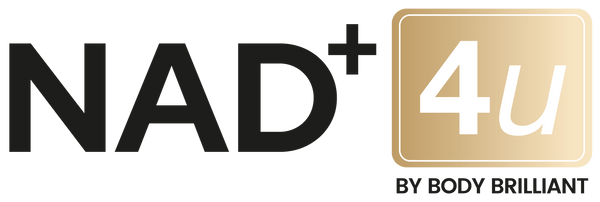NAD+ The Ubiquitous Coenzyme
Imagine a molecule so fundamental that life, as we know it, simply cannot exist without it. This molecule is Nicotinamide Adenine Dinucleotide (NAD+)—a ubiquitous coenzyme found in every cell of the human body. More than just a helper in biochemical reactions, NAD+ is a master regulator of metabolism, guardian of genomic integrity, and a key player in cellular signaling and immune defence.
Its presence is essential for energy production, DNA repair, stress response, and more. However, as we age, NAD+ levels decline—a process now linked to many signs of aging including fatigue, inflammation, reduced resilience, and cognitive decline.
This article unpacks the intricate biology of NAD+, its indispensable functions, why levels drop with age, and how modern therapies aim to restore this molecule for improved health and longevity.

1. NAD+ and the Engine of Life: Cellular Energy Production
At the core of life is energy, and NAD+ is the engine oil that keeps the energy machinery running smoothly.
Your body’s ability to generate ATP (adenosine triphosphate)—the energy currency of cells—relies heavily on NAD+. Through metabolic processes such as glycolysis, the citric acid cycle (Krebs cycle), and oxidative phosphorylation, NAD+ acts as an electron transporter. It cycles between its oxidised form (NAD+) and reduced form (NADH), enabling efficient energy transfer in cells.
Without adequate NAD+:
- ATP production decreases
- Cells become metabolically sluggish
-
Fatigue and poor organ function can set in
Furthermore, the NAD+/NADH ratio is a key indicator of cellular metabolic health. Maintaining this balance supports optimal enzyme activity and robust mitochondrial function.
2. The Guardian of the Genome: NAD+ and DNA Repair
Every cell in your body experiences DNA damage daily—from UV exposure, toxins, to internal metabolic byproducts. Without timely repair, this damage can lead to mutations and accelerated aging.
Here’s where NAD+ shines again—supporting two major DNA repair enzymes:
- PARPs (Poly ADP-Ribose Polymerases): Act quickly to repair DNA strand breaks. They consume NAD+ to recruit repair proteins to damage sites.
-
Sirtuins (SIRT1–7): These NAD+-dependent enzymes help regulate gene expression, support DNA stability, and suppress inflammation.
However, during times of stress or chronic DNA damage:
-
PARPs can overconsume NAD+, draining resources from other processes
-
This depletes cellular NAD+, impairing sirtuin activity
-
Resulting in genomic instability, inflammation, and mitochondrial dysfunction
Maintaining NAD+ levels is critical to keeping this repair balance intact—supporting both damage control and long-term cellular health.

3. Beyond Metabolism: NAD+ in Signalling & Immune Defence
NAD+ is not just a passive participant in metabolism—it also plays a central role in cellular signalling and immune regulation.
-
Intracellular signalling: NAD+ is a precursor to cyclic ADP-ribose (cADPR), a molecule that controls calcium signalling—key to nerve function, muscle contraction, and hormone release.
-
Immune modulation: NAD+ influences T cells, B cells, and macrophages. It helps balance inflammation and immune surveillance.
One enzyme to watch: CD38, a major NAD+ consumer in immune cells. Its activity rises with age and inflammation—often driving NAD+ depletion during “inflammaging” (chronic age-related inflammation).
Low NAD+ = weak immune responses + chronic inflammation
Maintaining NAD+ = immune balance + healthier ageing
4. The Dynamics of NAD+ Levels: Synthesis, Consumption & Decline
How the Body Makes NAD+
NAD+ is synthesised via three key pathways:
-
De Novo Pathway – From tryptophan (amino acid)
-
Preiss-Handler Pathway – From nicotinic acid (Vitamin B3)
-
Salvage Pathway – From recycled NAD+ byproducts like NAM, NR, and NMN (most efficient)
How the Body Consumes NAD+
- NAD+ is used by:
-
PARPs – For DNA repair
-
Sirtuins – For gene regulation & metabolic control
-
CD38 – In immune response (a major NADase)
-
Nudix Hydrolases – Lesser-known but active in stress
Why NAD+ Declines With Age
-
Increased consumption due to DNA damage & inflammation
-
Reduced synthesis efficiency as enzyme activity declines
-
Diminished precursor availability and lifestyle stressors
This decline accelerates many hallmarks of ageing—leading to energy deficits, impaired repair, inflammation, and chronic disease vulnerability.

5. Therapeutic Avenues: Boosting NAD+ for Health & Longevity
As the science of NAD+ expands, so does interest in replenishing it through safe, effective methods.
NAD+ Precursors
Nicotinamide Mononucleotide (NMN) and Nicotinamide Riboside (NR) are top candidates. These molecules are absorbed and converted into NAD+ via the salvage pathway. Shown to improve metabolism, muscle function, and resilience in preclinical studies
Delivery Methods
-
Oral Supplements: Convenient and effective for daily use
-
Injections: Offer rapid bioavailability and immediate results
-
IV Therapy: Systemic delivery used in clinical settings for intensive support
What the Research Says
Early human trials show promise: better energy, metabolism, inflammation control. Animal studies suggest potential for neuroprotection and longevity. More long-term data is still needed, but interest and investment in NAD+ science are growing rapidly
A New Era of Cellular Health
NAD+ is far more than a metabolic coenzyme—it’s a biological linchpin holding together energy, repair, immunity, and longevity.
Its decline is one of the most overlooked contributors to age-related deterioration. But the ability to restore NAD+ through smart supplementation and lifestyle choices offers a groundbreaking opportunity to improve vitality, resilience, and longevity.
Reignite Your Cellular Potential with NAD+ from NADPlus 4u
At NAD+ 4U, we offer pharmaceutical-grade NAD+ injections, supplements, and protocols designed to support your body at the cellular level.
✅ Boost your energy
✅ Enhance mental clarity
✅ Repair DNA damage
✅ Strengthen your immune system
✅ Slow the effects of ageing
Start your NAD+ journey today—because your cells deserve more.

